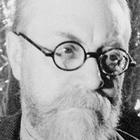
A Henri Matisse is regarded, along with Pablo Picasso, one of the fathers of modern painting. Linked to Post-Impressionism and representative in the beginning of Fauvism, Matisse worked masterfully color and pattern in search of a two-dimensional effect that would mark much of his work.
Early in his career he practiced drawing from life in a rather traditional style, as seen in The Breton Weaver, and made copies in the Louvre. He later went on to paint luminous landscapes of Corsica and the French Riviera.
In some of his painted figures by the end of the century the influence of Cézanne is present, but from 1907 his style became more defined and painted the fauve manner. Another peculiar feature is the sense of two-dimensionality of paintings like The Red Room.
By 1916 a period in which the influence of the Cubist movement, increasingly important, resulting in a more geometric concept of forms and even more, as in the painter and his model simplification perceived started.
In 1963 opened the Matisse Museum in Nice, which brings together some of his work.





